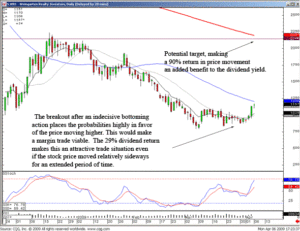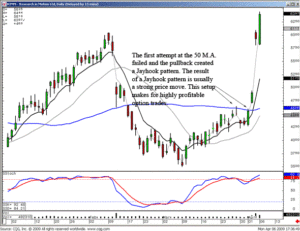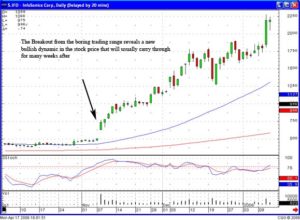When buying stocks on margin you can think of it as acquiring a loan from your brokerage firm. This type of trading allows the investors to buy more stock than they normally would be allowed to if he or she didn’t have a margin account.
Margin trading is all about leveraging. Leverage is the use of financial instruments or borrowed capital, to increase the potential return on investment. If you pick a good investment margin can drastically increase your profit, however it can also have the opposite effect if you don’t pick the right investment. Leveraging is great for helping investors and firms to invest and to operate even though it comes with great risk. It is just important to remember however, that leverage magnifies both gains and losses when investing in the stock market.
In order to buy stock on margin, you first must set up a margin account with a firm which is different from a cash account. There is a minimum deposit required that depends on the firm but is typically at least $2,000 if not more when margin trading. Once you have the margin account ready to go, then you can borrow up to 50% of the purchase price of the stock, but you don’t have to. You can borrow as little as 10% if you would like to when trading stock on margin. The requirement when margin trading is that your profits go to your stock broker against the prepayment of the loan first, and then you receive the rest. If after you pay back your broker your margin account goes below its minimum then a margin call occurs. You would then have to deposit more funds into your margin account to meet the minimum or sell stock to pay down the loan.
In addition to understanding margin calls and opening a margin account, you must understand the interest payments due. When margin trading, the securities in the account are collateral and you have to pay interest on your loan. This is why most traders buy stocks on margin when they are short term trading. The longer you hold the investment the more interest charges you will accrue. If when stock trading using a margin account you hold the investment for long amount of time, then the least likely you are to actually make a profit. As time passes and your debt level increases, the interest charges accrue and you lose money.
Margin trading is a great way to make money investing in stock, commodities, etc, however it requires a great amount of knowledge, focus, discipline and dedication. You must trade smart and you cannot let your emotions take over when trading on margin.
Most investors have a difficult time making money in the markets because they do not have a viable trading program. The first essential element of a successful trading program requires the identification of a price move. The reason most investors jump from one trading program to the next is due to the lack of confidence of the success of that trading program. The lack of success is usually created by two simple functions. The first is the credibility of a trading program. An investor needs to be convinced that trading program works profitably. There are hundreds of trading programs on the market that tell that they have found the “secret” for making big profits in the market. Obviously, an extremely high percentage have not found the secret because they have come and gone. Even successful trading programs require another important element. They have to be utilized correctly. Unfortunately, this creates a Catch-22. How many days, months, years does an investor spent on learning a trading system correctly? The gamble becomes how much time and effort will I put into learning how to use a trading program successfully when I’m not totally confident the trading program is a truly profitable program.
Candlestick analysis provides that initial key element! It does work successfully! Why is that true? Because if it didn’t, it would not be in existence today. It would have come and gone just like the many thousands of supposedly foolproof trading systems that have been marketed to the public for decades. Candlestick analysis works! The only aspect for making profits from the market is learning how to use candlestick analysis correctly. Imagine how you could improve your returns dramatically if you could place the proper trading strategy to the positions in your trading program. Having the confidence that the candlestick trading system works with a high percentage of profitable trades allows for concentrating on the best trading strategy to exploit profits. That can include margin strategies as well as option strategies. If a trading program has proven itself through hundreds of years of profitable results, an investor can then devise the best trading strategy or leverage to extract large profits from the markets.
Having the confidence to implement the proper trading strategy, without an underlying fear the basic trading program may or may not work, is extremely important for executing the correct trades. Knowing which direction a stock price should be moving allows for the assessment of the correct strategy. WRI is a recommended position for the longer-term investor. It is a REIT that is managed in a very conservative manner. It pays a $2.10 dividend. The price has been devastated just like all the REITs over this past year. The candlestick signals recently revealed good bottoming action. The price could move back up to the 200 day moving average, the $22 area. What would be the best trading strategy for this position? An option trade would create the best leverage. However, an option trade would not be able to take advantage of the current 17% dividend payout.
A margin trade may make much more sense. Buying the stock at $12.36 would produce close to an 90% return if the price move back up to the 200 a moving average. Buying two times the amount of stock using margin will make a very compelling trade. If the margin rate is 5%, the additional stock that can be bought on margin would produce a net 12% gain based upon the 17% dividend yield minus the 5% margin cost. Now the position yields 29% on its dividends while waiting for the possible 90% move to the upside. The worst-case scenario might be the stock trades relatively flat if the market was going flat. If the price does not move, a 29% dividend yield is still very worthwhile.

WRI
Candlestick analysis is merely a recognition of what investor sentiment has done in the past. The use of the candlesticks in different patterns and formations dramatically improves the participation potential of high profit price moves. As illustrated in the RIMM chart, simple candlestick analytical assessments help produce a very profitable option trading strategy. A test of the 50 day moving average, followed by a pullback to the T-line, followed by another test and breach of the 50 day moving average is usually an indication the Bulls will participate heavily with the formation of a Jayhook pattern breaching a major resistance level, the 50 day moving average. The results are simple. If the 50 day moving average is breached, obviously it is not acting as a resistance level anymore and the results of the Jayhook pattern should be in progress. These are not difficult setups to identify. They do represent new bullish investor sentiment potential.

RIMM
Recognizing the same pattern set up allows for powerful option strategies to be put into place. Candlestick analysis is merely the visual recognition of high profit trade setups. How an investor uses that information correctly dictates how strong returns will be. Take advantage of the information that has worked successfully for centuries. Then learn the trading strategies that can best exploit that information for big profits. You can control your own investment future by learning how to apply trade strategies that fit your comfort level.
Chat session tonight at 8 PM ET for members.
Good investing,
The Candlestick Forum Team
